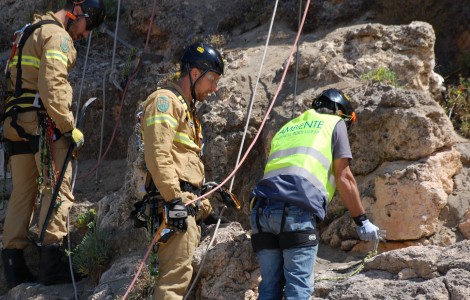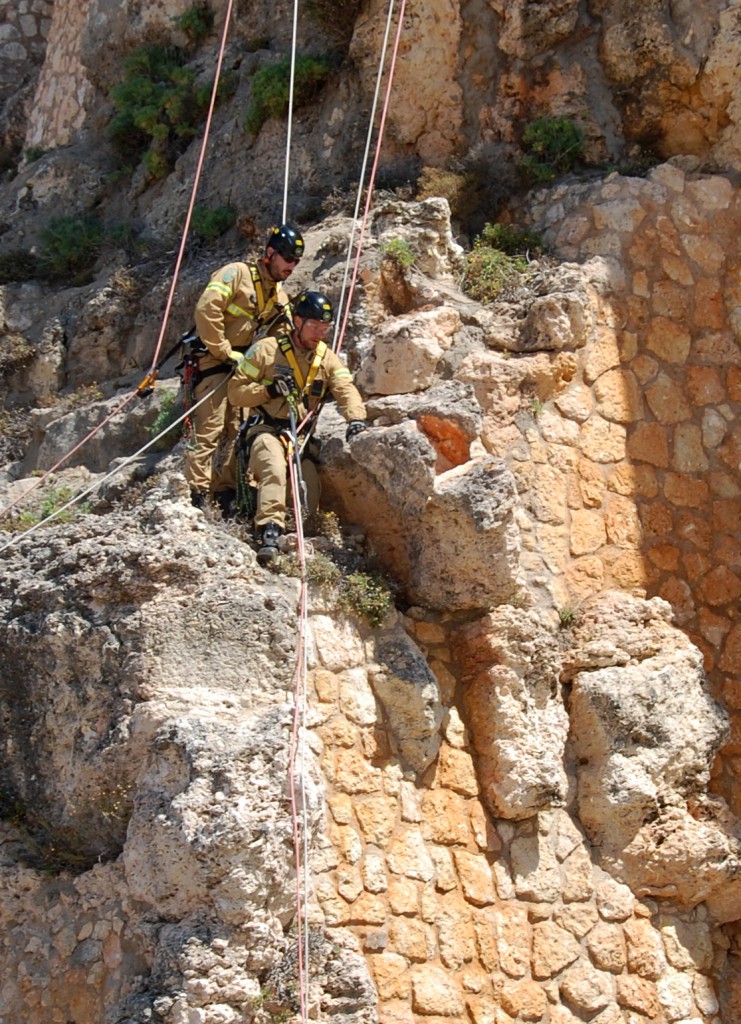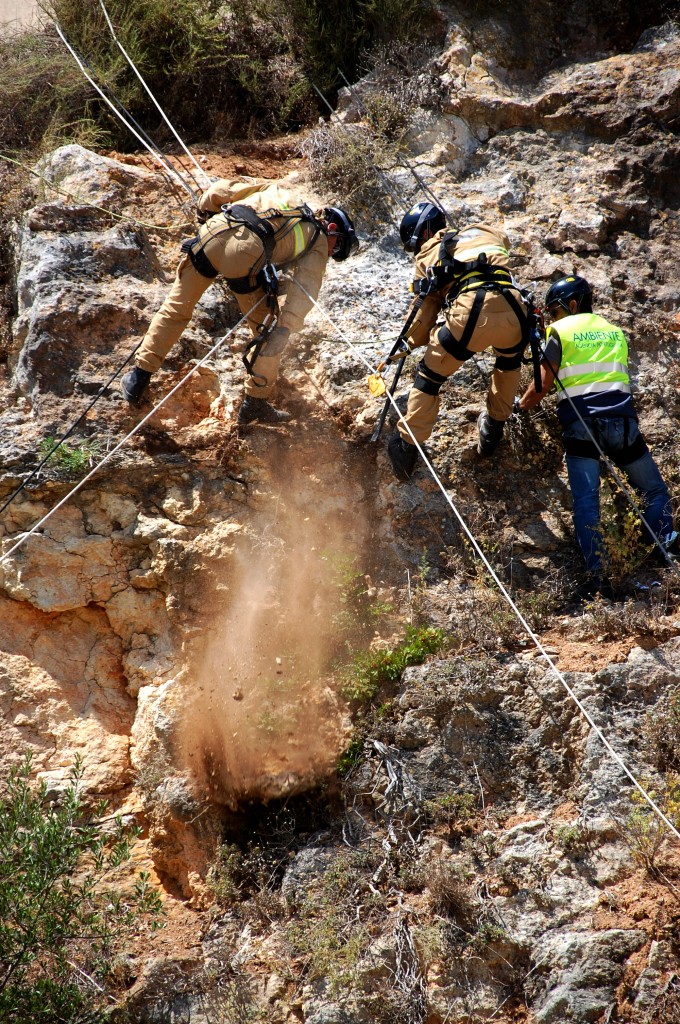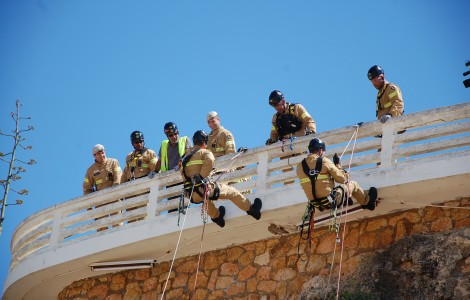 The controlled demolition operation of blocks on the cliff below the Forte de Santa Catarina, in Praia da Rocha, which is taking place throughout this Thursday, is as spectacular as it is unprecedented.
The controlled demolition operation of blocks on the cliff below the Forte de Santa Catarina, in Praia da Rocha, which is taking place throughout this Thursday, is as spectacular as it is unprecedented.
It is not every day that bathers and other onlookers can see members of the GNR Intervention Group for Protection and Relief (GIPS) (and a geologist from the Portuguese Environment Agency), duly armed and protected, doing recall down the cliff and dropping unstable stone blocks. In addition to the fact that it is the first time that these elements of GIPS, specialists in search and rescue in collapsed structures, participate in an operation to clean up the cliffs.
“This is the test of a partnership that we want to be extrapolable to the entire country. GNR has this operational capacity, we have limitations of action, so we are going to test this partnership», he told the Sul Informação responsible for the Portuguese Environment Agency/Administration of the Hydrographic Region of the Algarve.
 With the harness on and helmet on, soon geologist Sebastião Teixeira would be one of the men to descend down the cliff. The first intervention took place on the south side of the cliff, just under the stairs and landings that descend from the Fortaleza to Praia da Rocha, in the pier area.
With the harness on and helmet on, soon geologist Sebastião Teixeira would be one of the men to descend down the cliff. The first intervention took place on the south side of the cliff, just under the stairs and landings that descend from the Fortaleza to Praia da Rocha, in the pier area.
Side by side with two GIPS men, the APA/ARH geologist was giving them instructions on which blocks of rock to drop by hand, with the help of a crowbar and climbing hammers. Half a dozen blows, a bit of force with the crowbar pushed into a crack behind the stone, and here the blocks came loose from the cliff and fell down there, some of them ending up on the wooden walkway, access to which was barred. by the Maritime Police tapes.
«What we are doing here is to anticipate landslides, to make unstable stones fall so that they do not fall when we don't want to, namely when people are passing by the cliffs», explained the geologist responsible for the operation.
And how do technicians know that those are the areas at risk of falling? «They have all the symptoms that anticipate the imminent fall: cracks and cracks».
Cushions and compressed air to make stones fall

After a while, the team moved to another area, also close to the Forte de Santa Catarina, but now to the east, above the Clube Naval de Portimão warehouse, where there are always people passing by, namely sailors, kayakers and surfers.
And again the elements of GIPS plus geologist Sebastião Teixeira went down in recall, cliffs below. Only this time, in addition to the crowbar and hammer, they also used a kind of pillow, connected to tubes through which compressed air circulates.
These pillows, with the capacity to expand and lift several tons (according to their size), are placed, empty, in the cracks, and then filled with compressed air, which expands and swells them, widening the cracks and causing, in this case, to fall the stones.
GIPS operatives tried various sizes of pillows, but some didn't fit in the cracks, others couldn't open them, until they finally succeeded and yet another block of stone fell down the cliff. "This one no longer falls on anyone's head," commented a Maritime Police officer who was following the operation down here.
The apparatus of men hanging from cables on the cliff attracted, as is normal, the curiosity of many people, namely the bathers who entered and left the beach, many of them foreigners.
O Sul Informação I wanted to know why these GIPS operatives and the manual dismantling of unstable stones were resorted to instead of using machines. Once again, it was Sebastião Teixeira who replied: «machines cannot reach the height where we are going to work, it has to be something made from the top down. These are very surgical interventions, which the machine can hardly do, that's why we ask for the collaboration of GIPS from GNR».
More interventions, only after the summer

Isilda Gomes, mayor of Portimão, as well as his vice-president Castelão Rodrigues, also responsible for the Civil Protection department, accompanied the first phase of work at Praia da Rocha.
The mayor highlighted, in statements to journalists, the need for an intervention on the cliffs of the Fort of Santa Catarina: «it has been known for a long time that there is a danger of falling stones here and, therefore, it is necessary to guarantee the safety of citizens who they spend their holidays on our beach, which is why an intervention is urgent».
And why didn't the intervention take place before the bathing season? "This is a question that the APA will have to answer, but it will certainly have been because the means were not found before," replied Isilda Gomes, adding: "It is better to intervene now than never to intervene."
Despite the apparatus and the spectacle of real acrobats descending and climbing the cliffs as if it were easy, the truth is that the intervention in Praia da Rocha did not cause any problem for the bathers. On the contrary: they ended up having one more interesting thing to see.
 For now, and until the end of the bathing season, this is the last intervention of the APA/ARH on the Algarve cliffs. After the summer, Sebastião Teixeira announced, in his statements to journalists, that there will be an operation on Baleeira beach, in Sagres. "It's not a bathing beach, but the cliff has areas with symptoms of instability where we need to intervene."
For now, and until the end of the bathing season, this is the last intervention of the APA/ARH on the Algarve cliffs. After the summer, Sebastião Teixeira announced, in his statements to journalists, that there will be an operation on Baleeira beach, in Sagres. "It's not a bathing beach, but the cliff has areas with symptoms of instability where we need to intervene."
And with all these controlled collapses, made this year and in previous ones, is it not now necessary for people to be careful near the cliffs? «The cliffs are born to fall and we never know when they fall. Cautions are maintained in relation to the cliffs: people should move as far away from the cliffs as possible, ideally one and a half times the height of these cliffs», concluded Sebastião Teixeira.


















Comments